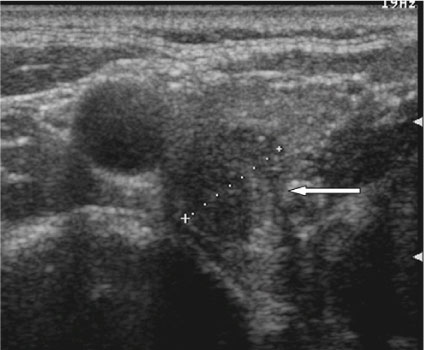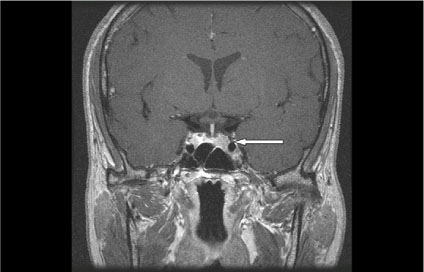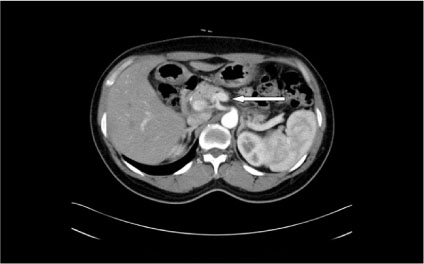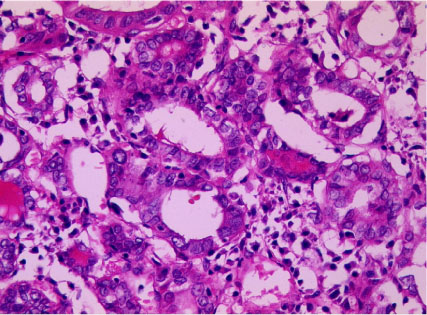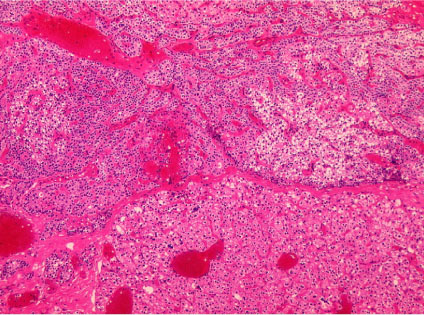J Korean Soc Endocrinol.
2006 Feb;21(1):79-84. 10.3803/jkes.2006.21.1.79.
A Case of Multiple Endocrine Neoplasia Type 1 with Papillary Thyroid Carcinoma
- Affiliations
-
- 1Department of Internal Medicine, Yonsei University College of Medicine, Seoul, Korea.
- 2Department of General Surgery, Yonsei University College of Medicine, Seoul, Korea.
- 3Department of Pathology, Yonsei University College of Medicine, Seoul, Korea.
- KMID: 2200673
- DOI: http://doi.org/10.3803/jkes.2006.21.1.79
Abstract
- This is the first report of papillary thyroid carcinoma combined with multiple endocrine neoplasia type 1 (MEN 1). It is an hereditary syndrome characterized by neoplastic disorders such as pituitary adenoma, parathyroid adenoma or hyperplasia and pancreatic neuroendocrine tumor, such as gastrinoma just like in our case. But sometimes pheochromocytoma, mucosal ganglioneuromas, lipoma, forgut carcinoid and thyroid disease could be accompany the disease, but coincidental papillary thyroid carcinoma was never reported before in Korea. Herein we represent a 39-year-old woman who manifested typical features of MEN 1 with coincidental papillary thyroid carcinoma. Despite with definite family history of MEN 1, her genetic analysis of DNA had not found any germline mutation in MEN 1 gene. Unidentified culprit gene unable further genetic study of finding LOH (loss of heterogeneity) in 11q13, the possible explanation of papillary thyroid carcinoma as a new component of MEN 1. As we have experienced a case of MEN 1 combined with papillary thyroid carcinoma, we report it with the review of literature.
MeSH Terms
-
Adult
Carcinoid Tumor
DNA
Female
Ganglioneuroma
Gastrinoma
Germ-Line Mutation
Humans
Hyperplasia
Korea
Lipoma
Multiple Endocrine Neoplasia Type 1*
Multiple Endocrine Neoplasia*
Neuroendocrine Tumors
Parathyroid Neoplasms
Pheochromocytoma
Pituitary Neoplasms
Prolactinoma
Thyroid Diseases
Thyroid Gland*
Thyroid Neoplasms*
DNA
Figure
Reference
-
1. Lairmore TC, Piersall LD, Debenedettil MK, Dilley WG, Whelan AJ, Jehnbauer B. Clinical genetic testing and early surgical intervention in patients with multiple endocrine neoplasia type1 (MEN 1). Ann Surg. 2004. 239:637–647.2. Chandrasekharappa SC, Guru SC, Manickam P, Olufemi SE, Collins FS, Emmert-Buck MR, Debelenko LV, Zhuang Z, Lubensky IA, Liotta LA, Crabtree JS, Wang Y, Roe BA, Weisemann J, Boguski MS, Agarwal SK, Kester MB, Kim YS, Heppner C, Dong Q, Spiegel AM, Burns AL, Marx SJ. Positional cloning of the gene for multiple endocrine neoplasia type 1. Science. 1997. 276:404–407.3. Dong Q, Debelenko LV, Chandrasekharappa SC, Emmert-Buck MR, Zhuang Z, Guru SC, Manickam P, Skarulis M, Liotta LA, Collins FS, Marx SJ, Spiegel AM. Loss of heterozygosity at 11q13: analysis of pituitary tumors, lung carcinoids, lipomas and other uncommon tumors in subjects with familial multiple endocrine neoplasia type 1. J Clin Endocrinol Metab. 1997. 82:1416–1420.4. Desai D, Mcpherson LA, Higgins JP, Weigel RJ. Genetic analysis of a papillary thyroid carcinoma in a patient with MEN 1. Ann Surg oncol. 2001. 8:342–346.5. Vortmeyer AO, Lubensky IA, Skarulis M, Li G, Moon YW, Park WS, Weil R, Barlow C, Spiegel AM, Marx SJ, Zhuang Z. Multiple endocrine neoplasia type 1: atypical presentation,clinical course, and genetic analysis of multiple tumors. Mod Pathol. 1999. 12:919–924.6. Park JH, Kim IJ, Kang HC, Lee SH, Shin Y, Kim KH, Lim SB, Lee K, Kim SY, Lee MS, Lee MK, Park JH, Moon SD, Park JG. Germline mutations of the MEN 1 gene in Korean families with multiple endocrine neoplasia type 1 (MEN 1) or MEN 1-related disorders. Clin Genet. 2003. 64:48–53.16. Larsson C, Skogseid B, Oberg K, Nakamura Y, Nordenskjold M. Multiple endocrine neoplasia type 1 gene maps to chromosome 11 and is lost in insulinoma. Nature. 1988. 332:85–87.17. Friedman E, Sakaguchi K, Bale AE, Falchetti A, Streeten E, Zimering MB, Weinstein LS, McBride WO, Nakamura Y, Brandi ML. Clonality of parathyroid tumors in familial multiple endocrine neoplasia type 1. N Engl J Med. 1989. 321:213–218.18. Chandrasekharappa SC, Teh BT. Functional studies of the MEN-1 gene. J Intern Med. 2003. 253:606–615.19. Brandi ML, Marx SJ, Aurbach GD, Fitzpatrick LA. Familial multiple endocrine neoplasia type 1: a new look at pathophysiology. Endocr Rev. 1987. 8:391–405.20. Marx SJ, Agarwal SK, Kester MB, Heppner C, Kim YS, Skarulis MC, James LA, Goldsmith PK, Saggar SK, Park SY, Spiegel AM, Burns AL, Debelenko LV, Zhuang Z, Lubensky IA, Liotta LA, Emmert-Buck MR, Guru SC, Manickam P, Crabtree J, Erdos MR, Collins FS, Chandrasekharappa SC. Multiple endocrine neoplasia type 1: Clinical and genetic features of the hereditary endocrine neoplasias. Recent Prog Horm Res. 1999. 54:397–438.
- Full Text Links
- Actions
-
Cited
- CITED
-
- Close
- Share
- Similar articles
-
- Multiple Endocrine Neoplasia and Familial Medullary Thyroid Carcinoma
- A Case of Multiple Endocrine Neoplasia Type 1 Combined with Papillary Thyroid Carcinoma
- A Case of Multiple Endocrine Neoplasia type 3 With Multiple Mucosal Neuroma
- A Case of Familial Medullary Thyroid Carcinoma
- A Case of Papillary Thyroid Carcinoma Combined with Multiple Endocrine Neoplasia Type 2A

